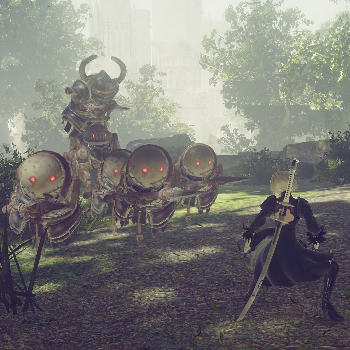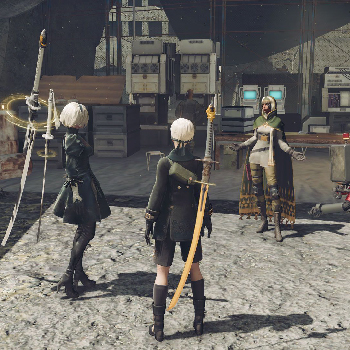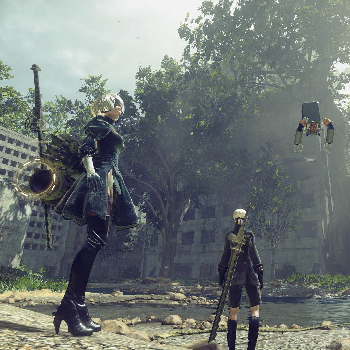
We live in a time where consumption of media is perhaps at an all time high. The volume and variety of media, whether it be visual, auditory, textual, or otherwise pervades our lives like never before. With media constantly available at our command with streaming services and digital downloads, our ability to consume this media is unmatched historically. The variety of media is also unparalleled. Television, movies, music, and novels have changed with modern technology allowing us to watch, listen, and read from a variety of devices. People compare television shows they have watched like trading cards due to the ease with which one can binge watch on Hulu and Netflix. With modern technology we have also been introduced to newer forms of media. Youtube videos, for example, satiate the attention span deprived kid in all of us with their bite size form.
Video games are also a modern form of media, and one could argue only recently coming into it’s own. A recent article by Ian Bogost titled “Video Games Are Better Without Stories” made the argument that video games can never match the story-telling of more solidified forms of media such as television, movies, and novels. Bogost believes that because video games are better at being visual environments that they should stop trying so hard to tell stories. Bogost argues that trying to tell stories that are on par with those found in television, movies, and novels is taking away from the strength of video games as a visual form of media that puts you in environments you could not otherwise be in. Unsurprisingly, many came out in defense of video games and their ability to tell stories, but the best counter-argument to me was simple one: video games simply have not found the best ways to tell stories within their medium yet. Story-telling simply hasn’t been refined in video games and it is possibly unfair to compare such a young form of media to television, movies, and novels who have decades and, in the case of books, centuries of refining their form.
This debate ran through my head recently as I played through Platinum Game’s Nier: Automata. Being a big Bayonetta fan, I was quite excited for Nier. After playing the demo for Nier, I was on board instantly. It was that over the top style that I love and Platinum is known for. What I didn’t expect was the story of Nier to make me think nearly as much as it did. As an English major in college, I became quite accustomed to reading a novel and then being able to have an open discussion about the inner workings of the prose with peers. Trading diatribe on what we believe to be the author’s meaning was always enjoyable and often needed to really understand a piece of literature as only through talking with others can you piece together it’s possible meanings. Nier gave me that same desire. Upon finishing, I began jotting down notes. The way Nier structured its story was different. Yes, it utilized some tropes other games have used, but that in itself is important and I will get to that in time.
By now, if you’ve heard about Nier: Automata, you know of it’s multiple “play-throughs” and endings. I placed play-throughs in quotations because the term is very misleading once you have played the game. Nier’s story is divided up into what I came to think of as episodes. You begin the game as the expected heroine, 2B, with 9S at her side for the bulk of the initial episode. 2B and 9S experience the world together for the most part, bantering back and forth as they meet the world’s characters and question what is happening on Earth’s human bereft surface. 9S struggles to hide the emotions 2B consistently reminds him they are not supposed to show. 9S regularly questions the actions of his de facto enemy, the robots who were unleashed on Earth by the aliens who attacked earth some time ago and who are also currently absent.
The robots, even as the perceived enemies, are important figures to consider given their behavior throughout the course of the game. Some of the most thought provoking scenes involve the nature, if you can call it that, of the robots. Much of the early game has 9S both pondering the actions of the robots while also casting them off as unintelligent and having no reasoning for their actions. 2B, ever stoic, rarely states an opinion on the actions of the robots, viewing them as the enemy she has been tasked to kill. Despite 9S insistence that the robots have no goal and no thought process, the duo of 2B and 9S often come across robots with goals such as becoming a karate expert whose body is strong enough to attain that goal. The two androids also come across robots having existential crises, a condition that leads to the robots committing suicide with no answers to their reason for being. Some robots struggle with the concepts of beauty and love, though this struggle is not seen entirely until what some deem the second “play-through” of the game.
From here on forward, I’m going to refer to the sequential play-throughs as episodes because that is what they feel like in my opinion. Akin to episodes of a television show, Nier: Automata unveils its story through lengthy play time as three separate characters. The second episode places you in the role of 9S, with the twist that you are playing out the same events of the first episode in which you played as 2B. Other games have done this before with playing out the same events from a different perspective. The Resident Evil games utilized this to some effect years back, but Nier uses this method as a way to enrich the story-telling and the game play. It’s in the second episode in which the game truly hits its stride as a both a story telling vessel and video game. The second episode opens with you in control of a robot attempting to bring a larger robot, who it refers to as brother, back to life through dumping oil on it. A seemingly innocuous scene is broken up by 9S as it is revealed that we are in the early moments of the entry point to the story from 2B’s episode. 9S comments on the futility of both the robot’s attempts to resuscitate his companion and the robot’s insistence that this other robot is their brother.
This choice to place this scene at the beginning stages of 9S episode is not just a sign to show us where in the story we are being dropped, but also as a bit of pacing to remind us what 9S was like prior to the events of 2B’s episode. This 9S believes that robot’s have no purpose and does not understand their seemingly human like behavior. 9S is also quite arrogant, but well-meaning as we are treated to his interactions with his operator rather than the operator we had become accustomed to during 2B’s episode.
The act of switching control to 9S is more than just an opportunity to play as another character and see the events from their perspective. 9S ability to hack into robots and as we would learn later, other androids, allows him insight and knowledge that we are not and cannot be privy to in 2B’s episode. The first big insight of hacking’s effect on world-building is in a boss fight against a robot who has ordained themselves in the parts of other robots in an attempt to make themselves beautiful. During 2B’s episode this boss, Beauvoir, just seems to be a robot gone mad, but 9S hacking gives us insight into what has brought Beauvoir to the point they are at and the pain the robot feels due to an unrequited love despite their attempts at what they believe to be beauty. Each subsequent hacking of Beauvoir gives more insight into the story and tragedy of the machine. Moments like these appear often in 9S episode and make 9S uncertainty towards the robots in the first episode all the more sensical. 9S ability to attain knowledge other androids cannot is a crucial part of the story in many ways, and the most impactful is the role in plays in his relationship with 2B.
Like in many games, completing the optional quests gives rewards of experience points and items for use on your adventure, but the quests in Nier: Automata build upon the world exponentially. Quests give insight to the robots, the resistance androids, and of course 2B and 9S through their reactions to these events. Plenty of other games utilize optional material as world-building, but with Nier you are doing yourself a disservice on not learning more about this world, devoid of humanity yet so affected by it. As you experience the world and it’s denizens, you see the the affect the absent humans have on it. The robots left on earth perform functions as if they are humans, some building families and showing affection. Some robots seek existential answers while others cannot handle their seemingly pointless and purposeless lives, if you can call their life cycle that. While other game’s side quests can make use of the world and help become more in tune with its creatures and characters, Nier’s side material enriches the very heart of the game and the message it seeks to deliver. To not experience as much of the side material as one can in Nier is the equivalent of skipping paragraphs in a novel or falling asleep during an episode of a television show.
Nier crescendos in its third episode as all the pieces come together and more comes to pass about the intentions of YorHa, 2B, 9S, and even the machines. It’s episodic story-telling puts you in the viewpoint of a third android that brings to light your usual twists and turns any enrapturing story goes through. The episodic shift in character focus is reminiscent of the story-telling style of popular book series A Song of Ice and Fire aka A Game of Thrones where the chapters are from the viewpoint of the various characters within the world. With only three playable characters, Nier: Automata’s story is much more concise yet just as vast and, in my opinion, thought provoking. Nier doesn’t just use a story to propel the action and take you from point A to point B, it utilizes various techniques to build a world, immerse you, and give insight to the creatures that dwell within. The end result is a story with a message worth thinking about, dare I say similar to that of a novel. Yes, Nier is weird and its characters and plot are a bit over the top, but its message is grounded and strong.
Nier: Automata is a major step in the story-telling of video games, a medium that has had difficulty finding its stride when it comes to telling stories. I found myself repeatedly saying, “this is a video game,” in an excited manner while playing Nier. The gameplay varies itself between all out action hack and slash, to bullet hell, to side scroller, and seemingly everything in between, but it is in the way it utilizes the gameplay to tell the story where these gameplay shifts show their true strength. I wasn’t given three characters to choose from or played as three characters for the simple reason to enjoy the gameplay of them. I played as those characters because their abilities and their viewpoints added to the story and offered a story-telling experience I had not had in a video game prior. Nier: Automata may not be the finest story told in video games, but it’s way of telling it’s story so tied into the gameplay showed me that stories in video games are still evolving and most importantly, worthy of being cultivated, studied, and improved upon.
- Ken Houston







